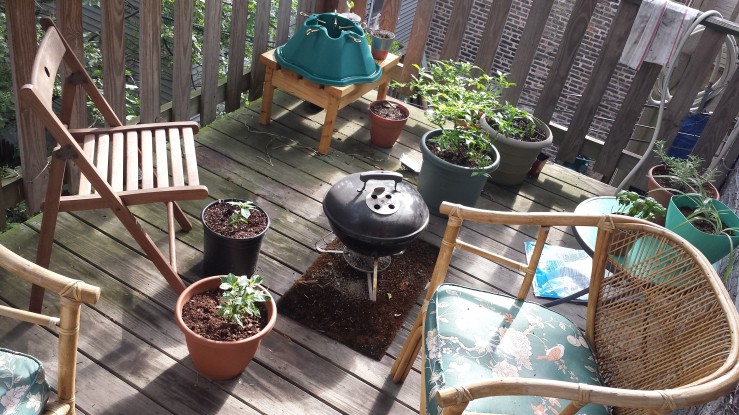Hello to our fellow denizens of the soil, tenders of the garden! Our plants are loving this weather and are growing with purpose, enjoying these temperatures and humidity far more than I am, where the sun and the temperatures provide a persuasive reason for staying in the shade and air conditioning. Not even the hot weather has been able to keep us away from our burgeoning harvest, as we have been able to pick peas and radishes, cut garlic scapes, and tend to the beds to ensure the plants, especially the finicky peppers, can grow as much as they can during these stretches of ideal weather.
In addition to our beds, we are growing plants in containers. We have several, which adds an extra dimension to what is already a challenging enough pursuit. Unlike a garden bed, you do not have as much control over the environmental variables you can expose your plants to nor do you have as many options for maintaining growth. Once it’s in a pot, it’s in a pot. About all you can do is water and fertilize it. You do not have the relative freedom provided by a bed: fewer ways to control moisture levels, limited space for roots to grow, better exposure to the environment. Containers do have one obvious advantage though. You can physically move them. Not getting enough sun or water? Maybe the other side of the deck is better. Not getting enough nutrients? All of that fertilizer is going to one plant.

The pros and cons of beds versus containers is one where the pros are firmly in favor of the bed, but you can still have success with a container. Living in rental apartments over the last few years has forced us to learn the best practices of container gardening, lest I end up empty handed. Other than large heirlooms, which I have given up all hope on successfully cultivating in a container, I’ve had varying levels of success. From an over wintered habanero to an especially precocious bell pepper plant, it is possible to have a good harvest even if it has to be done on your back porch or in your front window. Here are a few of the most important things I’ve noted from my attempts the last few years, bountiful and futile alike:
- Water. Unlike in a bed, where it’s hard to over water to the point of killing them because it’ll run off, if the pot is not well drained or in the sun, it’ll stay moist a lot longer than a bed will, meaning root rot is a distinct possibility. Only water when you are sure the dirt is completely dry or the plant has begun to wilt.
- Sunlight. This is one area where containers can be better than gardens. You have to work within the limitations of your space, but you can sometimes better accommodate the light needs of your plants because of the portability of pots.
- Fertilizer. This is a the toughest part and the lesson it took me the longest to learn. Even an unfertilized garden will have nutrients passing into the soil consistently from organic matter, worms, animals, and more entering the ecosystem. A pot is a relatively self-contained environment. Once the nutrients from the soil are gone, they’re gone and if your plants runs out of nutrients while it’s trying to fruit, you’ll be out of luck.
- Pot size. This is one case where bigger is better. Never underestimate the ability of a plant to grow roots. In a garden bed they’ll be able to go down as deep as they need, but in a container they’ll be constrained. Use as a big of a pot as you can manage to give your plant the most room to expand. Not to mention a bigger pot will hold more nutrients, decreasing the amount you need to fertilize.
- Optimism. Sometimes you just need to keep at it and hope for the best. Last year we had a black bell pepper that put out three delicious peppers by August and then nothing. We kept at it, watering and fertilizing regularly, and got another dozen peppers before the first frost.
Does anyone out there have any tips for container gardening? I’d love to be able to grow full-size heirloom tomatoes some year! Until next time!

I always plant peppers and tomatoes with about a tablespoon of Epsom salts mixed in the soil that they go into, and then put a good layer of mulch around the base of the plant so that they keep their water in. The best tips I are always going to be around watering consistently – we got drip irrigation hoses for our raised beds last year and have it on the timer to run for 5 hours starting at 5 a.m., 2 days a week. Unless the temperature goes above 90 that has always led us to great results… And if it goes into the 90s for multiple days we throw old white bed sheets from Goodwill over the cages so the peppers and tomatoes don’t get sunburnt. I’ve never used fertilizer on these and they do great 🙂
LikeLiked by 1 person
lovely tips here 🙂
LikeLike
Good tips on over-watering in pots.. But all are looking good.. 🙂
LikeLike
Hi Hot Pepper. Charmed Garden here. So how’s your garden doing in this humidity? I am surprised by the weather because all the predictions said it’d be hot and dry. It’s only hot and dry between all the rain and humidity. Our community garden took quite a hit in the heat early on but has bounced back with the recent rain. There is absolutely no shade whatsoever there.
LikeLike